Fatigue Behavior of Heavy-Haul Railway Prestressed Concrete Beams Based on Vehicle-Bridge Coupling Vibration
Abstract
:1. Introduction
2. Experimental Program
2.1. Materials and Specimens
2.2. Test Procedures
2.3. Test Results
2.3.1. Static Performance
2.3.2. Fatigue Failure Modes
2.3.3. Development of the Displacement and Main Crack
2.3.4. Development of Strain
3. Modelling
3.1. Models
3.1.1. Fatigue Life Models of Steel and Concrete
Fatigue Life of Steel Bar
Concrete Constitutive Model and Fatigue Life
3.1.2. Vibration Model of the Heavy-Haul Train
3.1.3. Vibration Model of the Track-Bridge System
3.2. Numerical Methods
3.2.1. Fatigue Behavior Analysis Based on Vehicle-Rail-Bridge Coupling Vibration
- (1)
- The finite element model of the bridge was established in the finite element analysis software; the vehicle system dynamics model was established in SIMPACK [33].
- (2)
- The modal analysis and substructure analysis of the bridge finite element model were performed, and the flexible body FBI files were generated and imported into SIMPACK [33].
- (3)
- Spring damping was used to set up the track layers connection, and the primary and secondary suspension system of the train; the wheel-rail contact was used to realize the coupling effect of the track and bridge.
- (4)
- The normal time-history force of wheel-rail contact point under the excitation of track irregularity was analyzed for trains with different axle weights. The expected values of wheel-rail force were calculated and applied to the finite element model in Figure 15. The stress of the tensile reinforcement was simulated to determine the fatigue test analysis load.
3.2.2. Model Validation and Analysis
3.2.3. Fatigue Behavior Assessment Model
- (1)
- The finite element model of prestressed concrete beams was established. The material parameters of concrete, prestressing strand, tensile steel bars, and stirrups were input. The material parameters were consistent with the test beams.
- (2)
- The effective prestress of the prestressing strand before fatigue loading was calculated according to Equations (17) and (18). The initial prestress was applied to the prestressing strand by the cooling method.
- (3)
- The stress amplitude of tensile steel bars, prestressing strand, and concrete in the compression zone under fatigue loading was determined. The fatigue life was calculated according to Equations (2), (3) and (13).
- (4)
- After n fatigue cycles, the fatigue elastic modulus damage of concrete in the compression zone, the effective bearing area of the prestressing strand, and the tensile steel bars was calculated according to Equations (5) and (11). Then, the material properties were redefined.
- (5)
- After n fatigue cycles, the maximum stress of concrete in the compression zone, prestressing strand, and tensile steel bars of beam midspan and loading point section was calculated.
- (6)
- The damage of prestressed concrete beam was assessed by whether the concrete in the compression area, prestressing strand, and tensile steel bars reached the ultimate strength, i.e.,Yes: the fatigue life of prestressed concrete beams N = n.No: n = n + Δn, return to step (4) and continue calculation.
3.2.4. Validation through the Test Results
4. Model Application and Analysis
4.1. Fatigue Life of the Beam
4.2. Stiffness Degradation
4.3. Post-Fatigue Strength
5. Conclusions
- (1)
- When the trainload was lower than the cracking load and the beam was not cracked yet, the beams exhibited excellent fatigue performance, and the degree of prestressing will not affect the fatigue life. When the trainload exceeded the cracking load of the beam, the crack resistance of the prestressed concrete beam was poor, and the fatigue life of the beam decreased significantly with the increase in the trainload and prestress loss. The fatigue failure of prestressed concrete beams occurred in the bottom tensile steel bar. Therefore, it is reasonable to take the number of fatigue fracture cycles of tensile steel bars as the fatigue life of the beams.
- (2)
- The crack development process of prestressed concrete beams displayed three stages: derivative stage, gradual development stage, and fatigue failure stage. Compared with partially prestressed concrete beams, fully prestressed concrete beams were more sensitive to cracks. Once cracked, the bottom tensile steel bar of the beams can easily undergo fatigue failure. Hence, the cracking of fully prestressed concrete beams should be strictly controlled.
- (3)
- The static strength of prestressed concrete beams after fatigue loading was related to the fatigue damage degree. When the trainload was lower than the cracking load and the beam was not cracked yet, the degree of prestressing had little effect on the stiffness of the beam. When the beam was cracked with the accumulated fatigue damage or the trainload was greater than the cracking load of the beam, the concrete in the tension zone will gradually withdraw from work, and the force of the prestressed tendons will increase. Therefore, with the increase in the number of trainload fatigue cycles, the effect of prestress loss on the stiffness of the beam was more significant. With the increase in the trainload, the greater the fatigue damage degree of the prestressed concrete beam under the same fatigue cycles, and the greater the influence of prestress loss on the stiffness of the beam. Therefore, when the axle weight of the heavy-haul train is greater than the cracking load of beam, it is suggested to strengthen the beam by increasing prestress level.
- (4)
- The increase in train load and prestress loss in the beams accelerates the degradation rate of yield-bearing capacity. The higher the degree of yield capacity degradation, the more pronounced the influence of fatigue load level and prestress loss on the yield capacity. When the trainload was lower than cracking load (cracking coefficient was 0.9) and the number of fatigue cycles was 3.45 million, the yield capacity of the beam decreased by 15%. Under the same degradation degree of yield capacity, when train load was greater than cracking load and the cracking coefficient increased from 0.9 to 1.03, the number of fatigue cycles of heavy-haul train decreased by 20%. The number of fatigue cycles decreased by 37.4% when the cracking coefficient increased from 0.9 to 1.03, and prestress loss increased by 20%. Therefore, when the prestressed concrete beam reaches a certain degree of fatigue damage, the axle weight of heavy-haul train should be strictly controlled to avoid yield failure of the beam.
Author Contributions
Funding
Institutional Review Board Statement
Informed Consent Statement
Data Availability Statement
Conflicts of Interest
References
- Pu, Q.; Wang, H.; Gou, H.; Bao, Y.; Yan, M. Fatigue behavior of prestressed concrete beam for straddle-type monorail tracks. Appl. Sci. 2018, 8, 1136. [Google Scholar] [CrossRef] [Green Version]
- Li, J.Z.; Yu, Z.W. Study on the Effect of Fatigue in 32 m-span PC Simply Supported T-type Beams on Existing Line Due to Heavy-haul Transport. Railw. Stand. Des. 2014, 58, 56–61. [Google Scholar]
- Jia, J.Z.; Si, D.L. Target Profile of Rail Grinding for Small Radius Curve of Shuohuang Railway. Zhongguo Tiedao Kexue China Railw. Ence 2014, 35, 15–21. [Google Scholar]
- Yu, Z.W.; Li, J.Z.; Song, L. Experimental study on fatigue behaviors of heavy-haul railway bridges. China Civ. Eng. J. 2012, 45, 115–126. [Google Scholar]
- Song, L.; Yu, Z.W. Fatigue damage experiments of heavy haul railway prestressed concrete beams using fiber bragg grating sensing technology. Jianzhu Jiegou Xuebao J. Build. Struct. 2019, 40, 58–66. [Google Scholar]
- Yu, Z.W.; Shan, Z.; Yuan, J.; Li, X. Performance deterioration of heavy-haul railway bridges under fatigue loading monitored by a multisensor system. J. Sens. 2018, 2018, 5465391. [Google Scholar] [CrossRef] [Green Version]
- Prashanth, M.H.; Singh, P.; Kishen, J.M.C. Role of longitudinal reinforcement on the behavior of under reinforced concrete beams subjected to fatigue loading. Int. J. Fatigue 2019, 125, 271–290. [Google Scholar] [CrossRef]
- Dai, L.Z.; Bian, H.B.; Wang, L.; Potier-Ferry, M.; Zhang, J.R. Prestress loss diagnostics in pre-tensioned concrete structures with corrosive cracking. J. Struct. Eng. 2020, 146, 04020013. [Google Scholar] [CrossRef]
- Ren, J.X.; Qie, Y.H.; Xie, H.X. Fatigue analysis of 75kg/m-12 heavy-haul railway frog based on finite element simulation. Eng. Fail. Anal. 2020, 117, 104799. [Google Scholar] [CrossRef]
- Younes, T.; Al-Mayah, A.; Topper, T. Fatigue performance of prestressed concrete beams using BFRP bars. Constr. Build. Mater. 2017, 157, 313–321. [Google Scholar] [CrossRef]
- Au, F.; Du, J.S. Partially prestressed concrete. Prog. Struct. Eng. Mater. 2004, 6, 127–135. [Google Scholar] [CrossRef]
- Castilho, V.; Debs, M.; Nicoletti, M. Using a modified genetic algorithm to minimize the production costs for slabs of precast prestressed concrete joists. Eng. Appl. Artif. Intell. 2007, 20, 519–530. [Google Scholar] [CrossRef]
- Naaman, A.E. Fatigue in partially prestressed concrete beams. In: Recent research in fatigue of concrete structures. ACI Publ. 1982, SP-75, 25–46. [Google Scholar]
- Huang, Y.; Wei, J.; Dong, R. Stiffness of corroded partially prestressed concrete T-beams under fatigue loading. Mag. Concr. Res. 2018, 72, 1800187. [Google Scholar] [CrossRef]
- Ren, Y.T.; Qiu, X.M.; Yu, T.X. The sensitivity analysis of a geometrically unstable structure under various pulse loading. Int. J. Impact Eng. 2014, 70, 62–72. [Google Scholar] [CrossRef]
- Huszár, Z. Vibrations of cracked reinforced and prestressed concrete beams. IABSE Symp. Rep. 2008, 6, 155–164. [Google Scholar] [CrossRef]
- Kashani, M.M.; Maddocks, J.; Dizaj, E.A. Residual Capacity of Corroded Reinforced Concrete Bridge Components: State-of-the-Art Review. J. Bridge Eng. 2019, 24, 03119001. [Google Scholar] [CrossRef] [Green Version]
- Song, L.; Cui, C.; Liu, J.; Yu, Z.; Jiang, L. Corrosion-fatigue life assessment of RC plate girder in heavy-haul railway under combined carbonation and train loads. Int. J. Fatigue 2021, 151, 106368. [Google Scholar] [CrossRef]
- Bonopera, M.; Chang, K.C. Novel method for identifying residual prestress force in simply supported concrete girder-bridges. Adv. Struct. Eng. 2021, 24, 136943322110220. [Google Scholar] [CrossRef]
- Li, J.Z.; Yu, Z.W.; Song, L. Study on fatigue deflection and crack propagation laws of heavy-haul railway bridges. J. Civ. Eng. 2013, 46, 72–82. [Google Scholar]
- Song, L.; Hou, J. Fatigue and post-fatigue monotonic behaviour of partially prestressed concrete beams. Mag. Concr. Res. 2016, 68, 109–117. [Google Scholar] [CrossRef]
- Zhao, W.Z.; Wei, H.L.; Fang, J. The theory and application of the virtual fatigue test of welded structures based on the master S-N curve method. Hanjie Xuebao Trans. China Weld. Inst. 2014, 35, 75–78. [Google Scholar]
- Feng, A.M. Modeling of Fatigue Crack Propagation. Trans. ASME J. Eng. Mater. Technol. 2004, 126, 77–86. [Google Scholar]
- Kim, S.M.; Rashid, K.; Abu, A.R. Meso-scale computational modeling of the plastic-damage response of cementitious composites. Cem. Concr. Res. 2011, 41, 339–358. [Google Scholar] [CrossRef]
- GB 50010-2015; Code for Design of Concrete Structures. China Architecture& Building Press: Beijing, China, 2015.
- Wu, J.Y. Elastoplastic Damage Constitutive Model of Concrete Based on Damage Energy Release Rate and Its Application in Structural Nonlinear Analysis; Tongji University: Shanghai, China, 2004. [Google Scholar]
- Du, Y.X.; Jun, W.; Jian, Y. Experimental research on fatigue behavior of prestressed concrete beams under constant-amplitude and variable-amplitude fatigue loading. Constr. Build. Mater. 2020, 259, 119852. [Google Scholar] [CrossRef]
- TB 10092-2017; Code for Design of Concrete Structures of Railway Bridge and Culvert. China Railway Press: Beijing, China, 2017.
- Kachanov, L.M. Time of the rupture process under creep condition. Izv. Akad. Nauk. SSSR Otd. Tek. 1958, 8, 26–31. [Google Scholar]
- Haraj, M.H.; Naaman, A.E. Static and fatigue tests on partially prestressed beams. J. Struct. Eng. 1985, 111, 1602–1619. [Google Scholar] [CrossRef]
- Zhao, L.Y.; Yang, L.Q.; Shan, Z. Investigation of the Fatigue Behaviour of a Ballastless Slab Track–Bridge Structural System under Train Load. Appl. Sci. 2019, 9, 3625. [Google Scholar] [CrossRef] [Green Version]
- Shan, Z. Stochastic Damage Model for Concrete and Its Application; Central South University: Changsha, China, 2017. [Google Scholar]
- Bernstein, A.; Kaufmann, E.; Kiefer, C.; Bürki, C. SimPack: A Generic Java Library for Similarity Measures in Ontologies; University of Zurich: Zürich, Switzerland, 2006. [Google Scholar]
- Wang, H.M. Research on the Wheel-Rail Dynamic Effect of Heavy-Duty Truck; Southwest Jiaotong University: Chengdu, China, 2006. [Google Scholar]
- Zhai, W.M. Vehicle-Track Coupled Dynamics; Science Press: Beijing, China, 2015. [Google Scholar]
- Ministry of Railways of the people’s Republic of China. Code for Design on Reinforced and Prestressed Concrete Structure of Railway Bridge and Convert; TB10002.3-2005; China Railway Publishing House: Beijing, China, 2005. [Google Scholar]
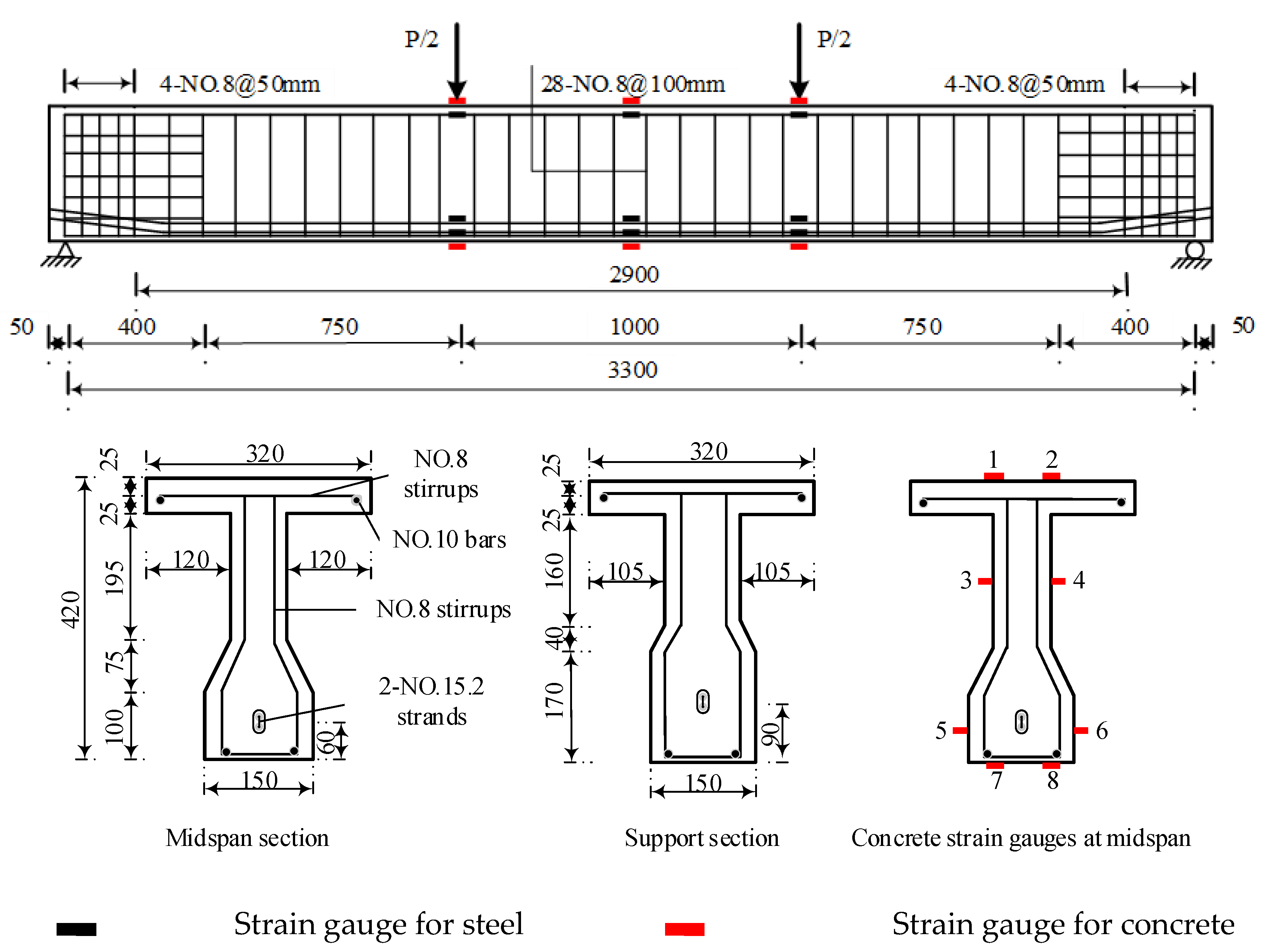
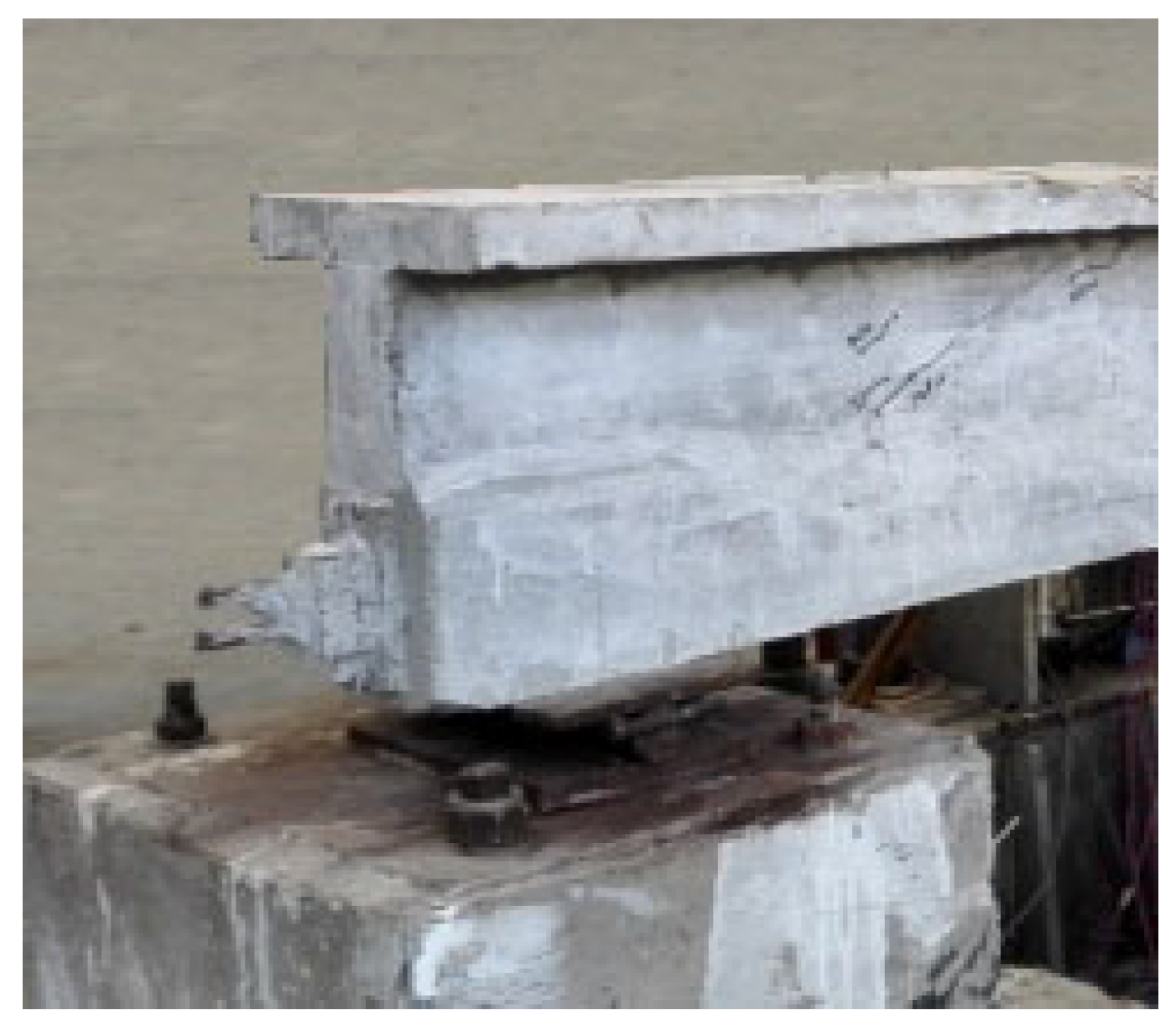


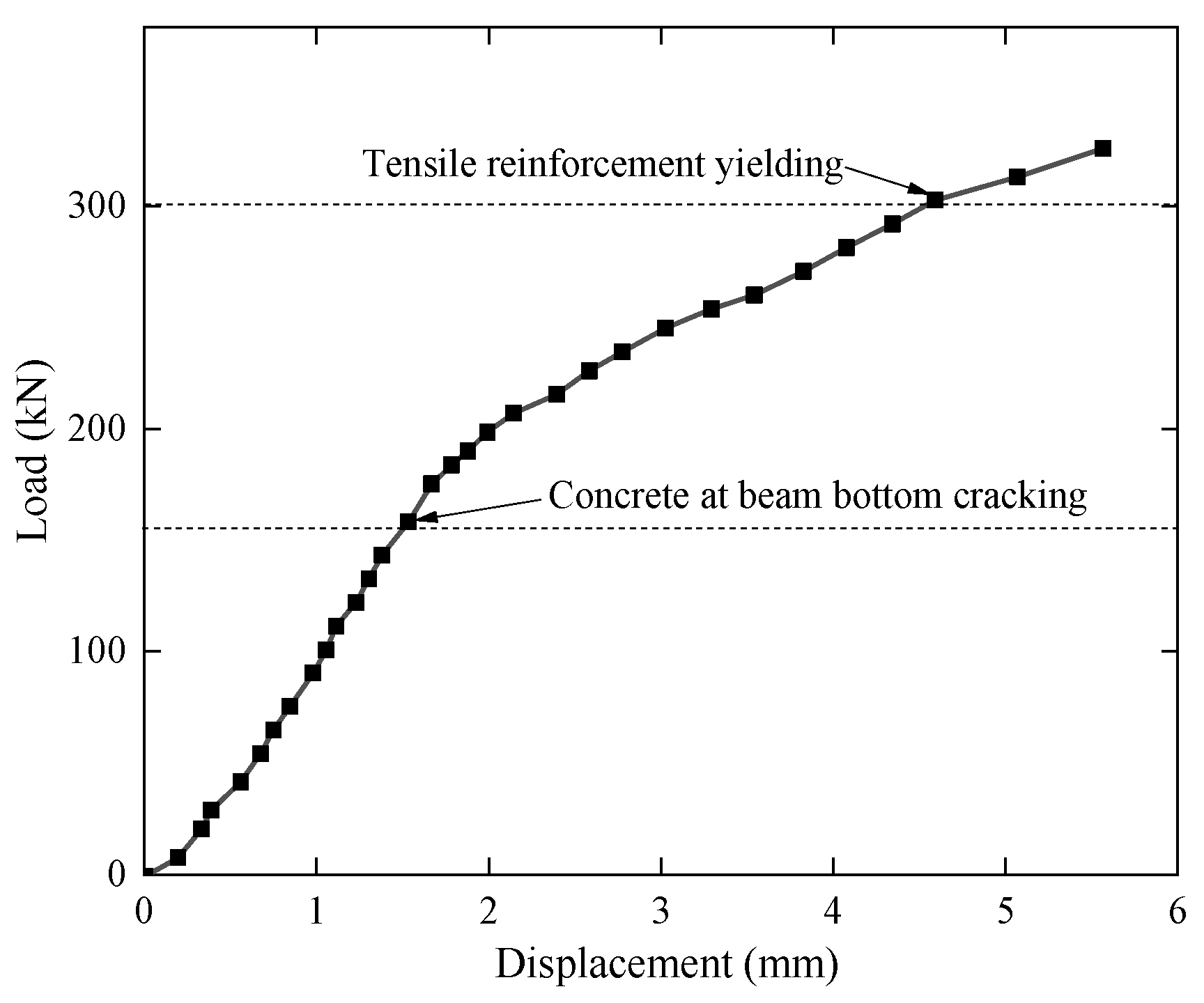

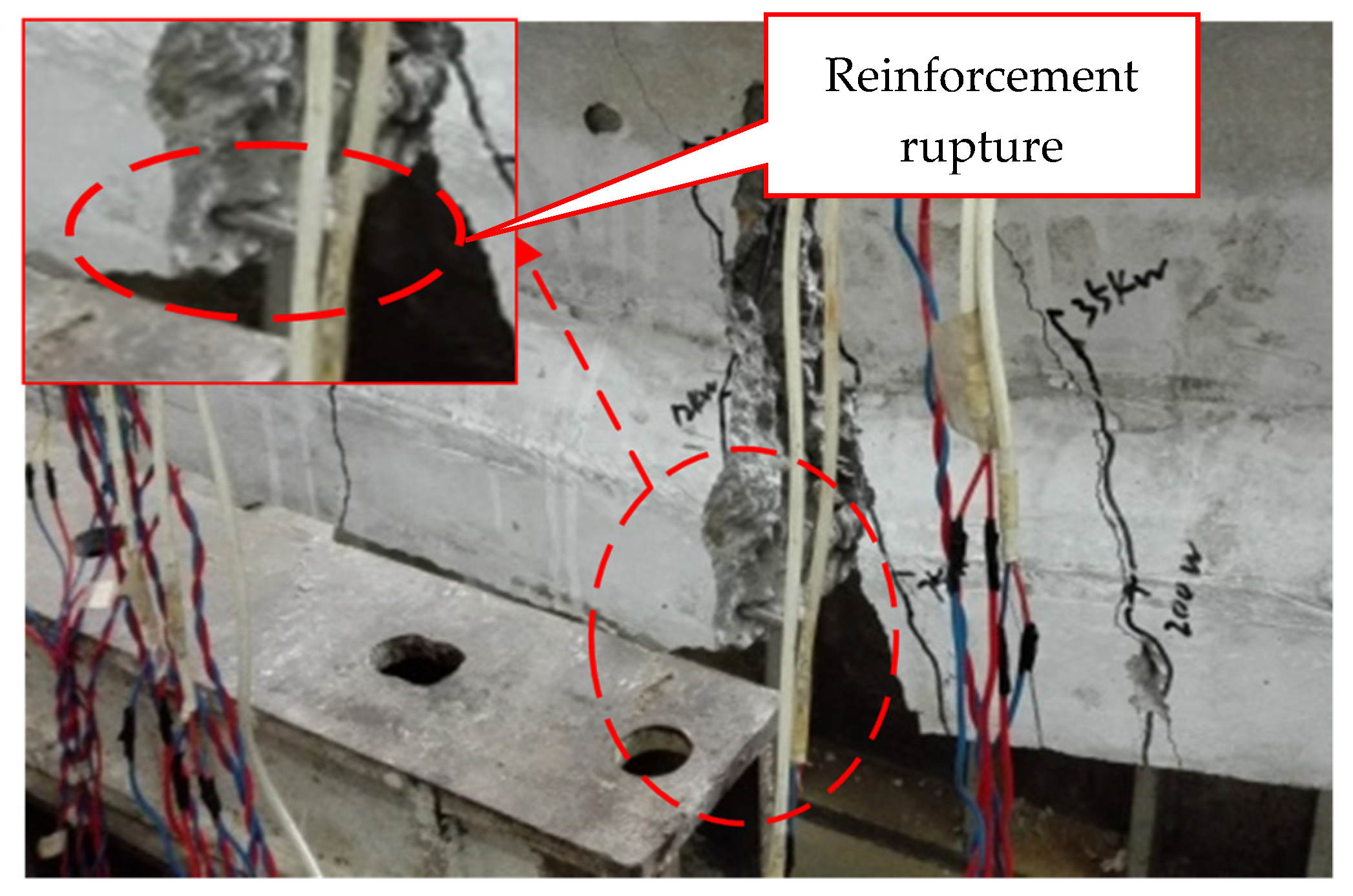




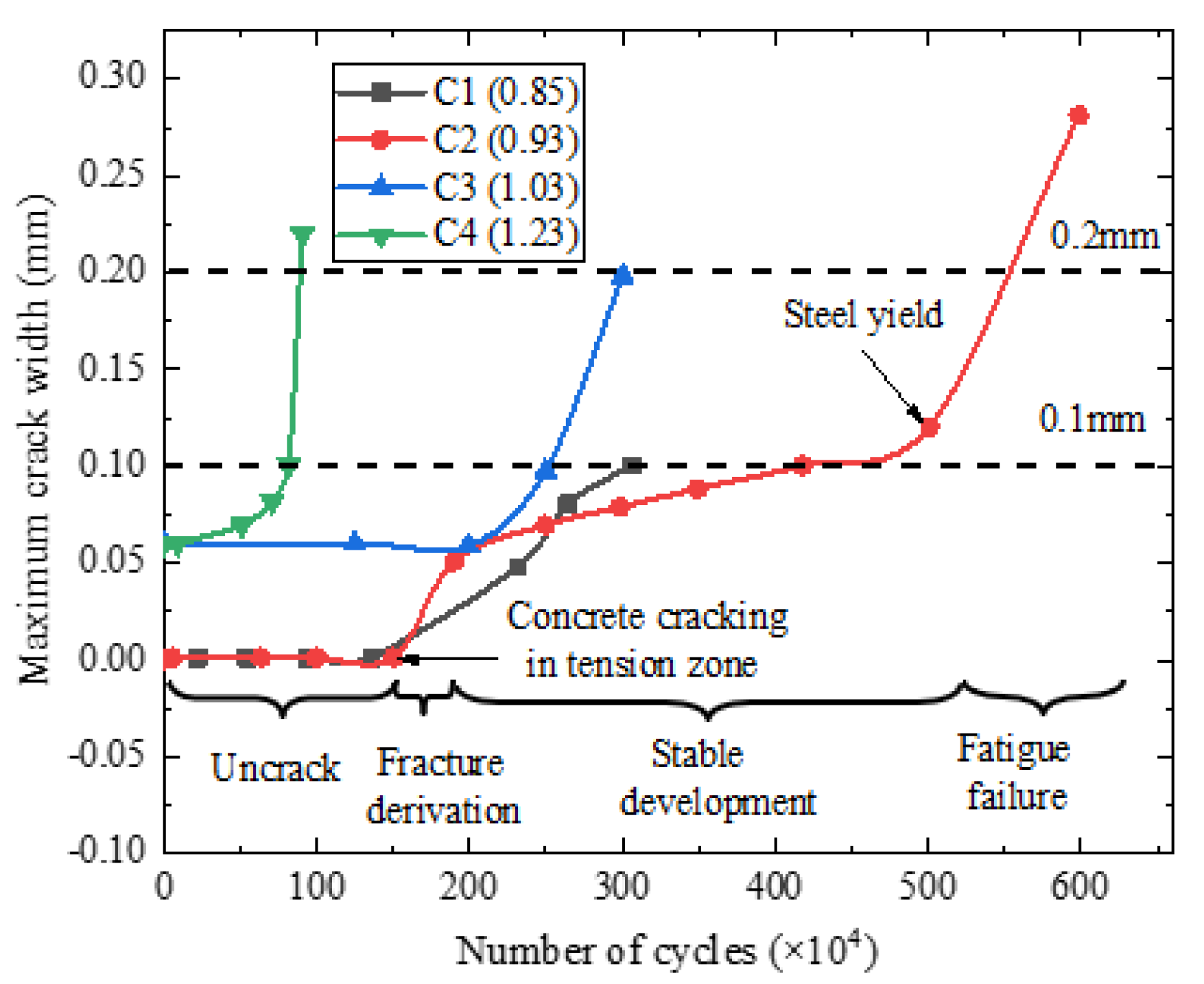
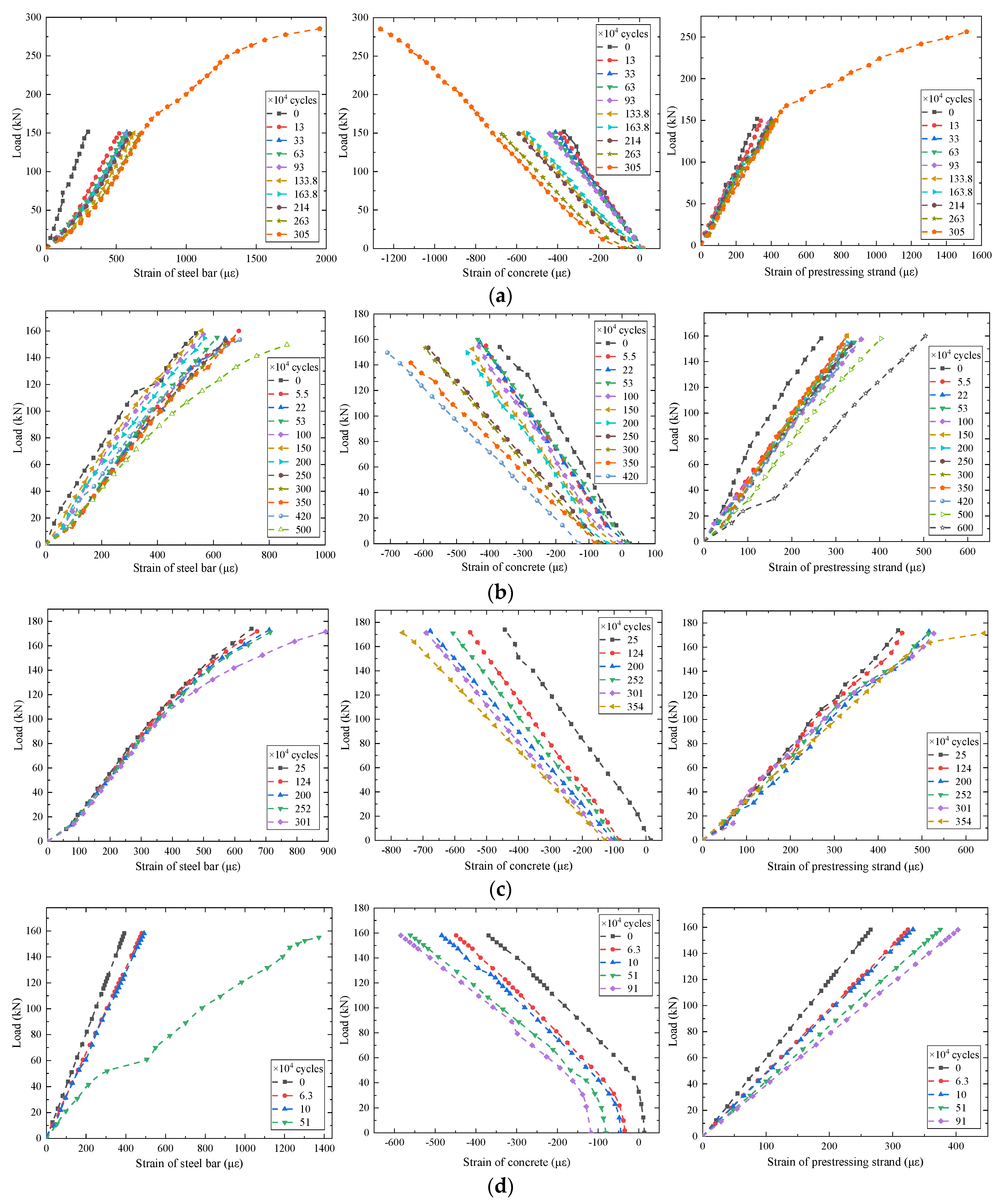
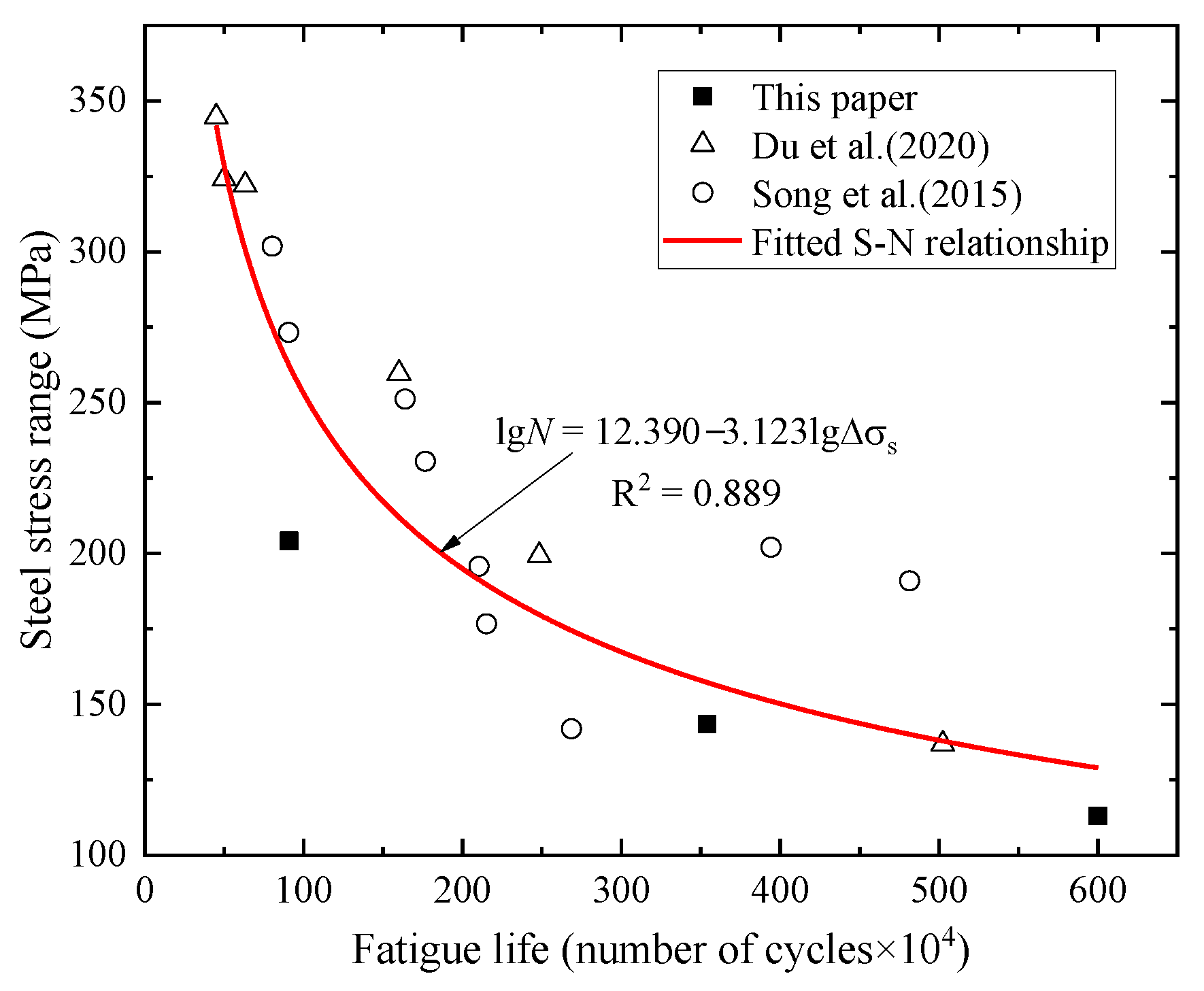
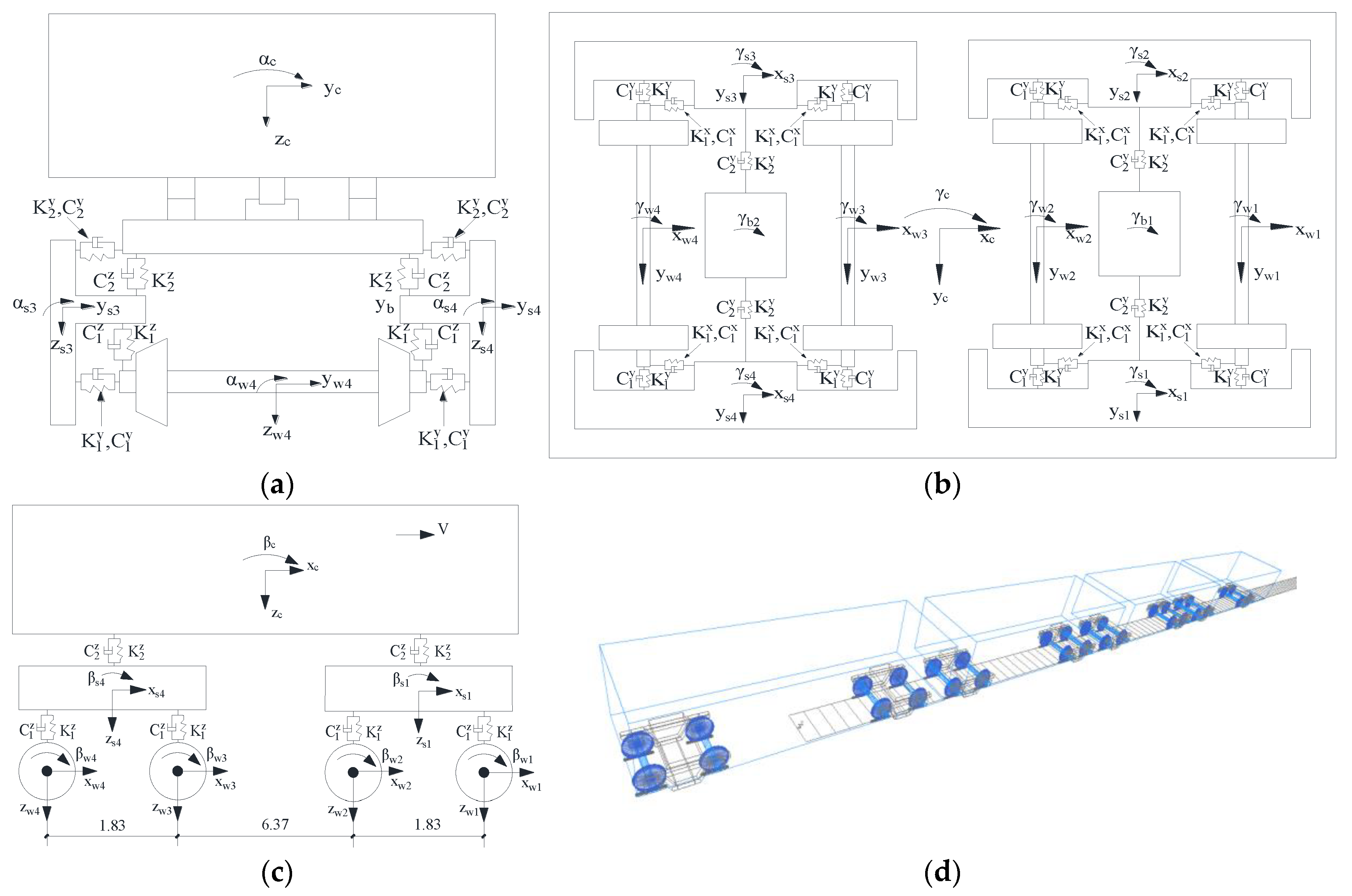

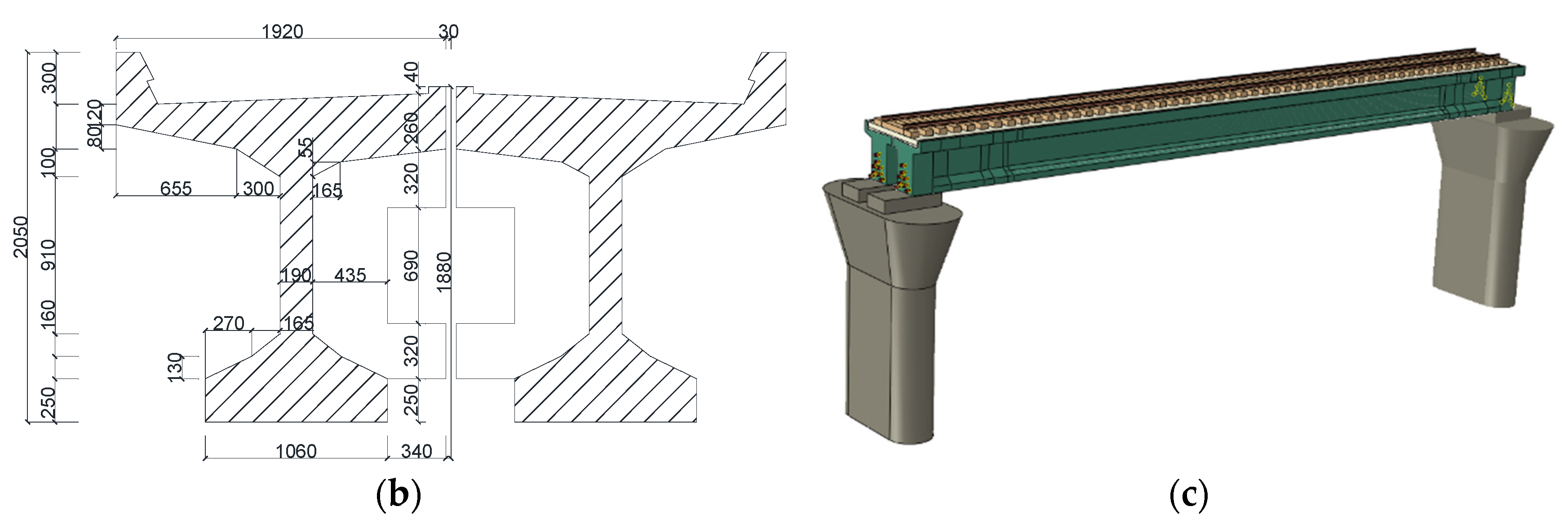
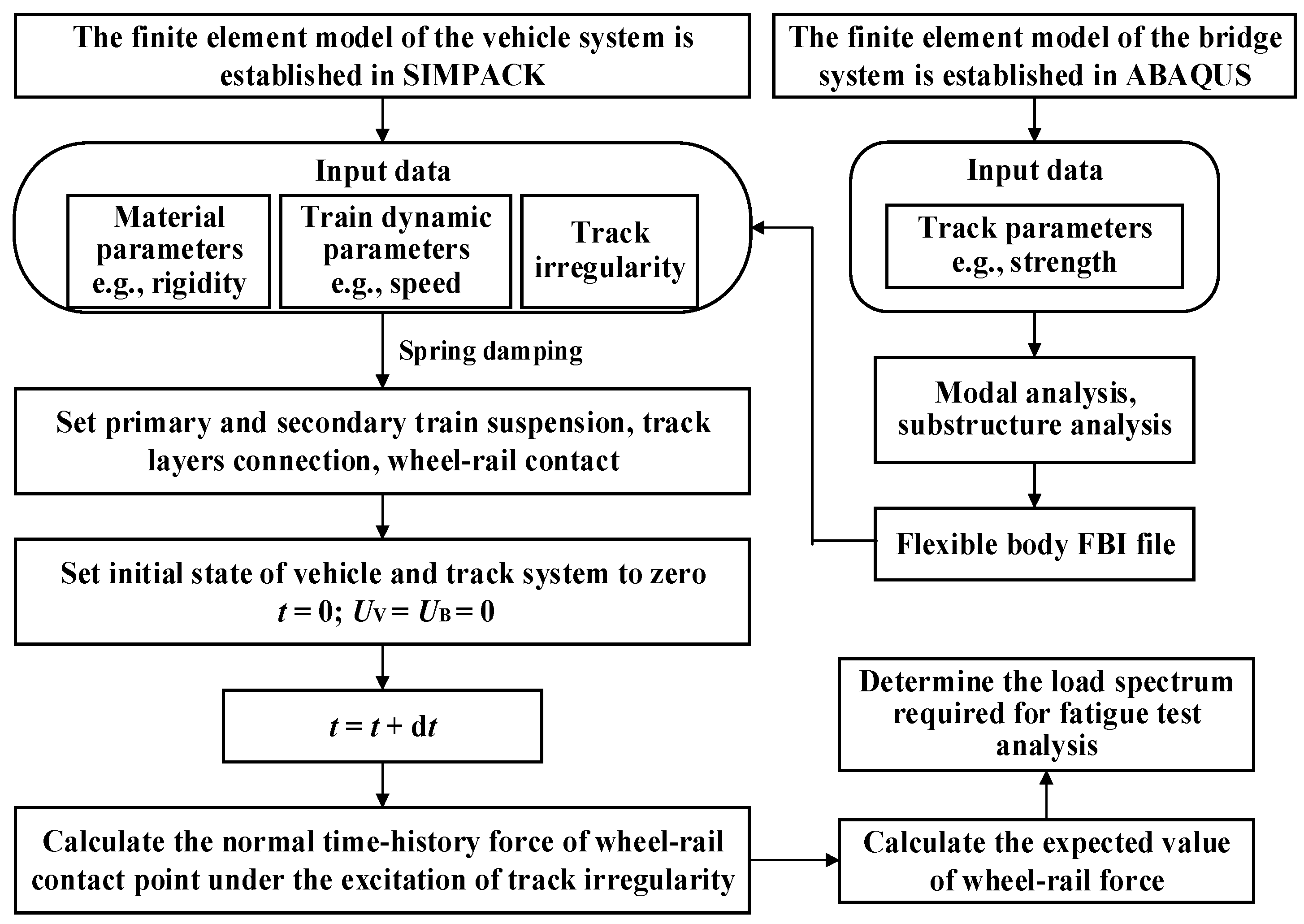

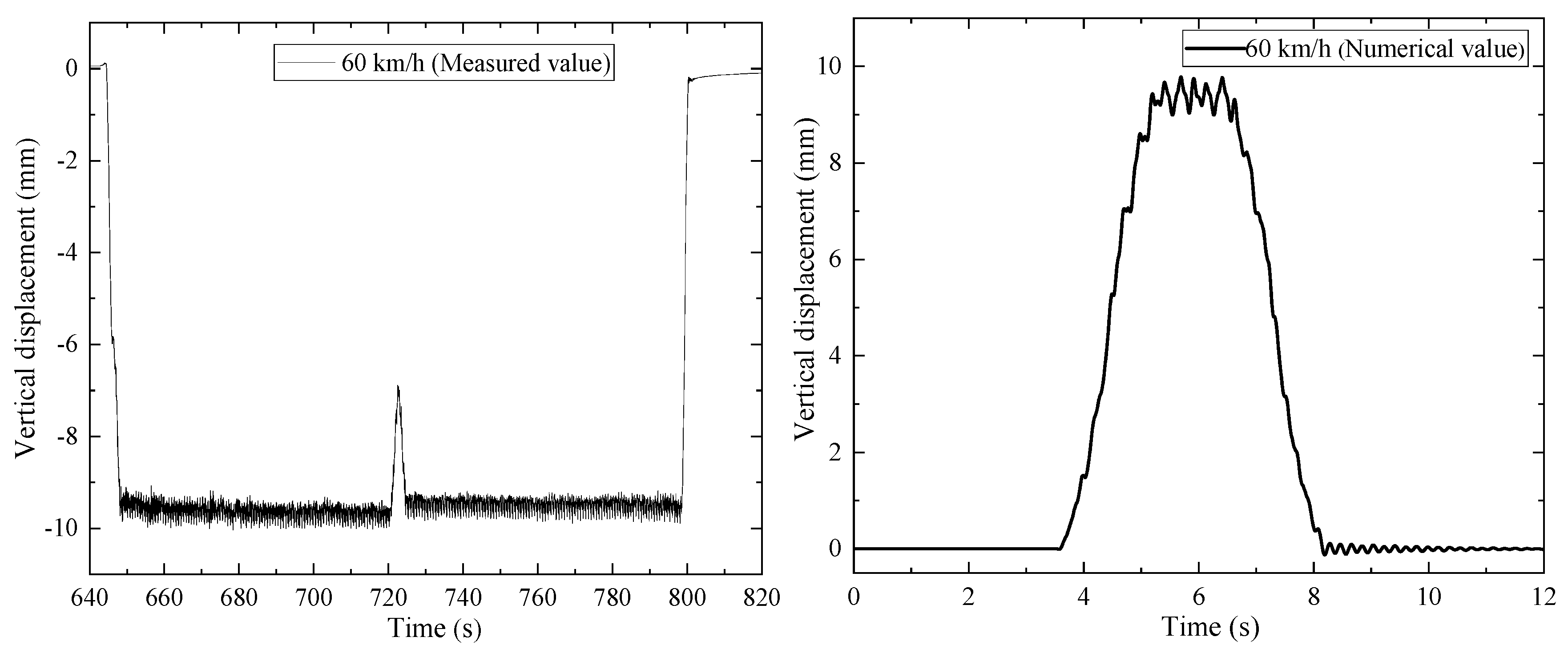
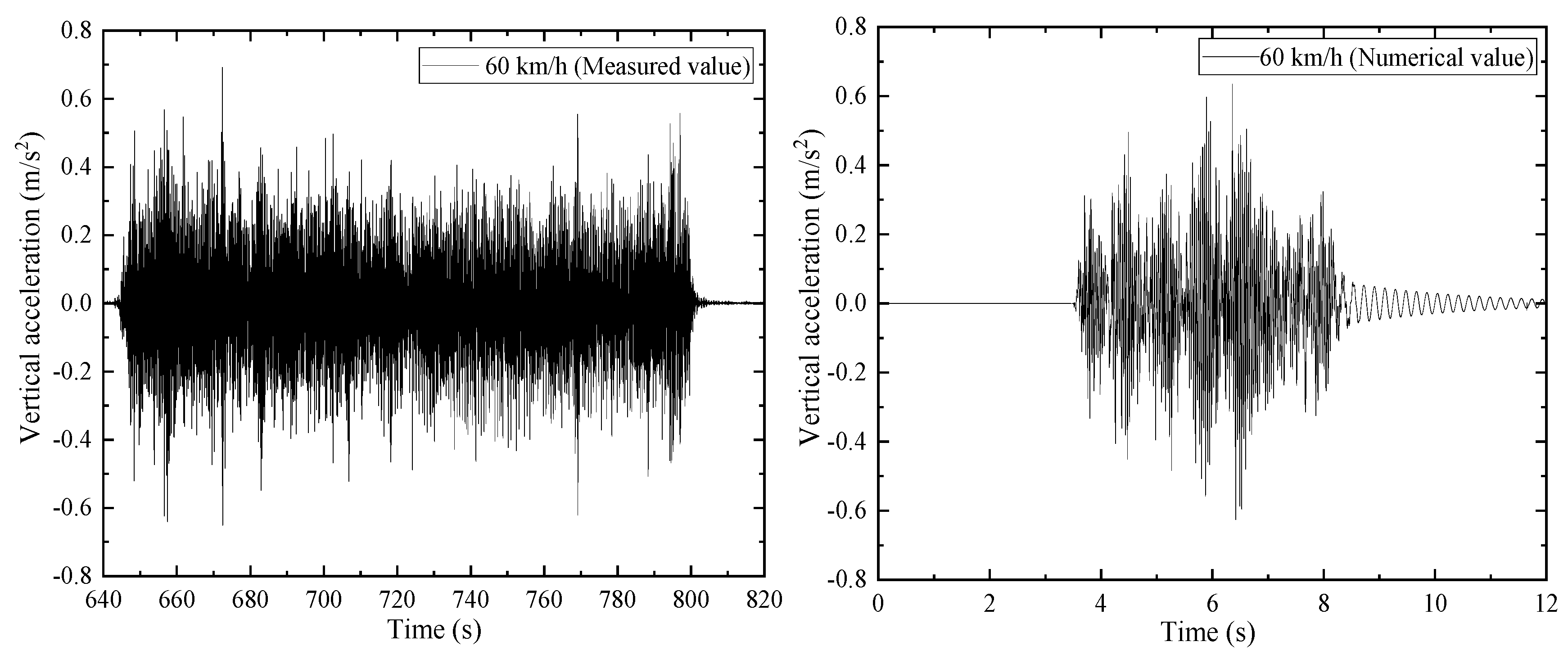
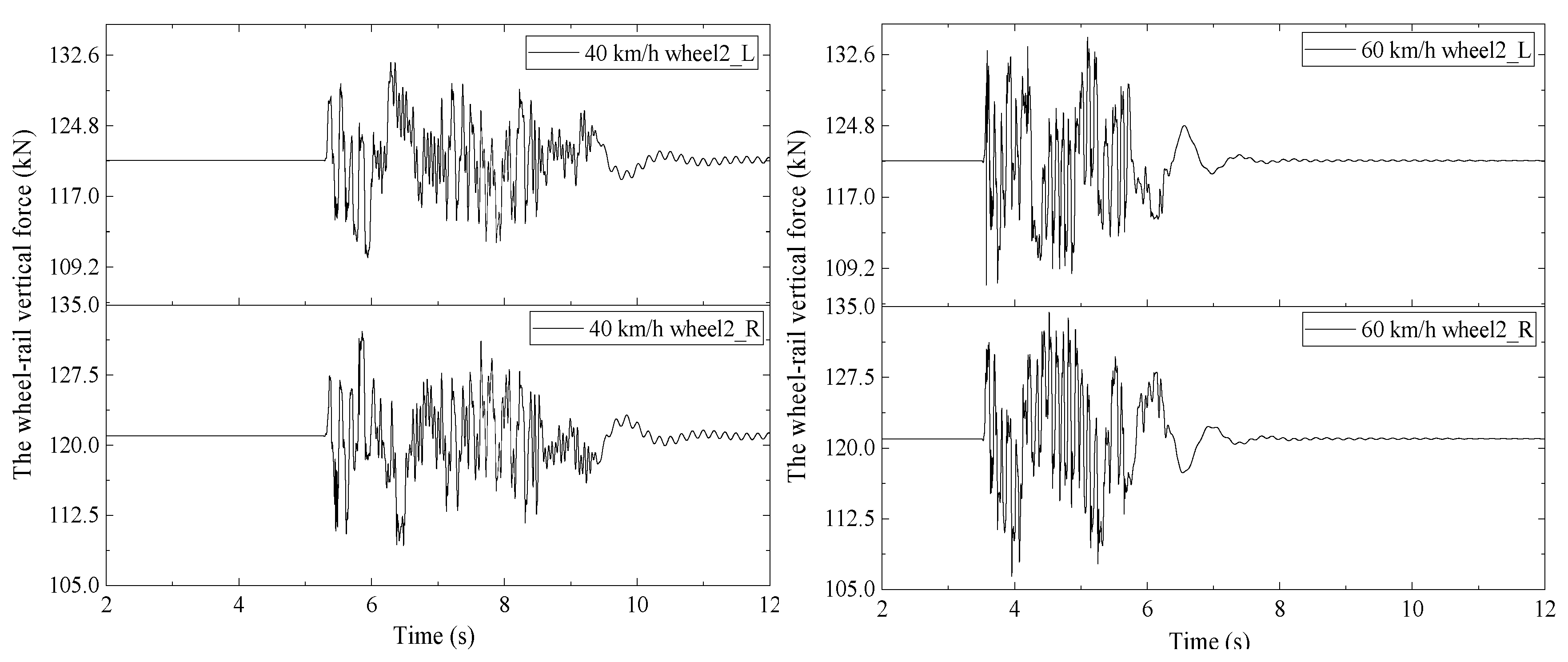
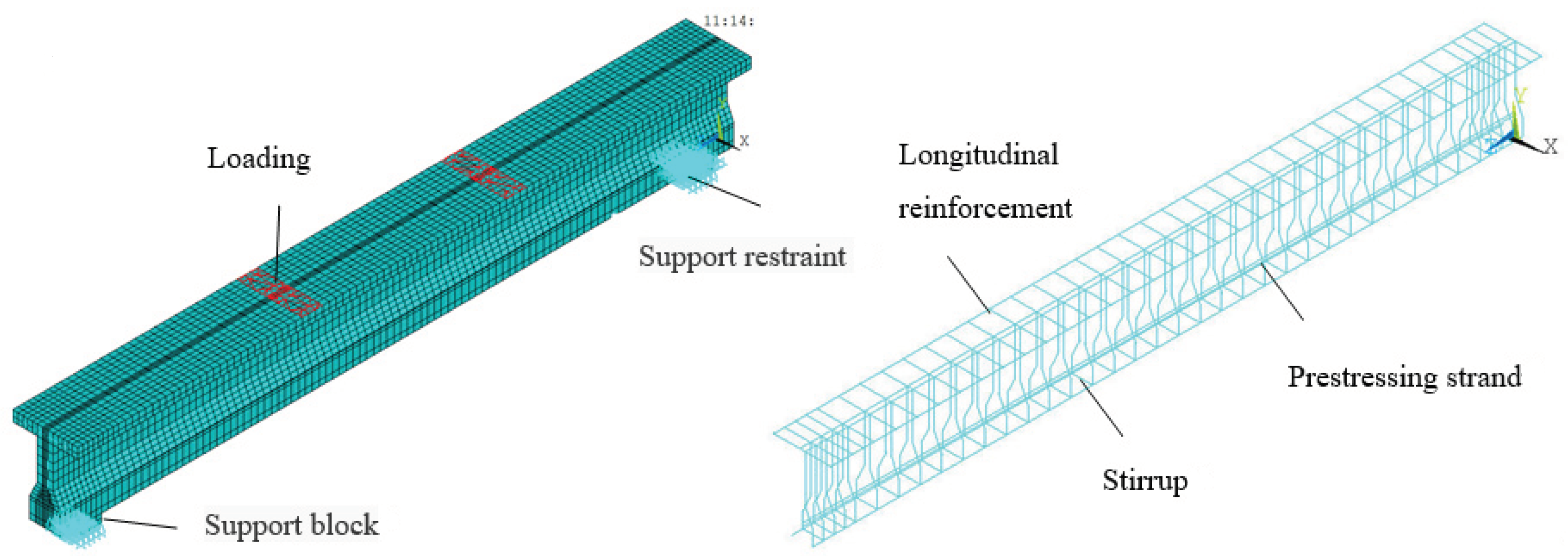


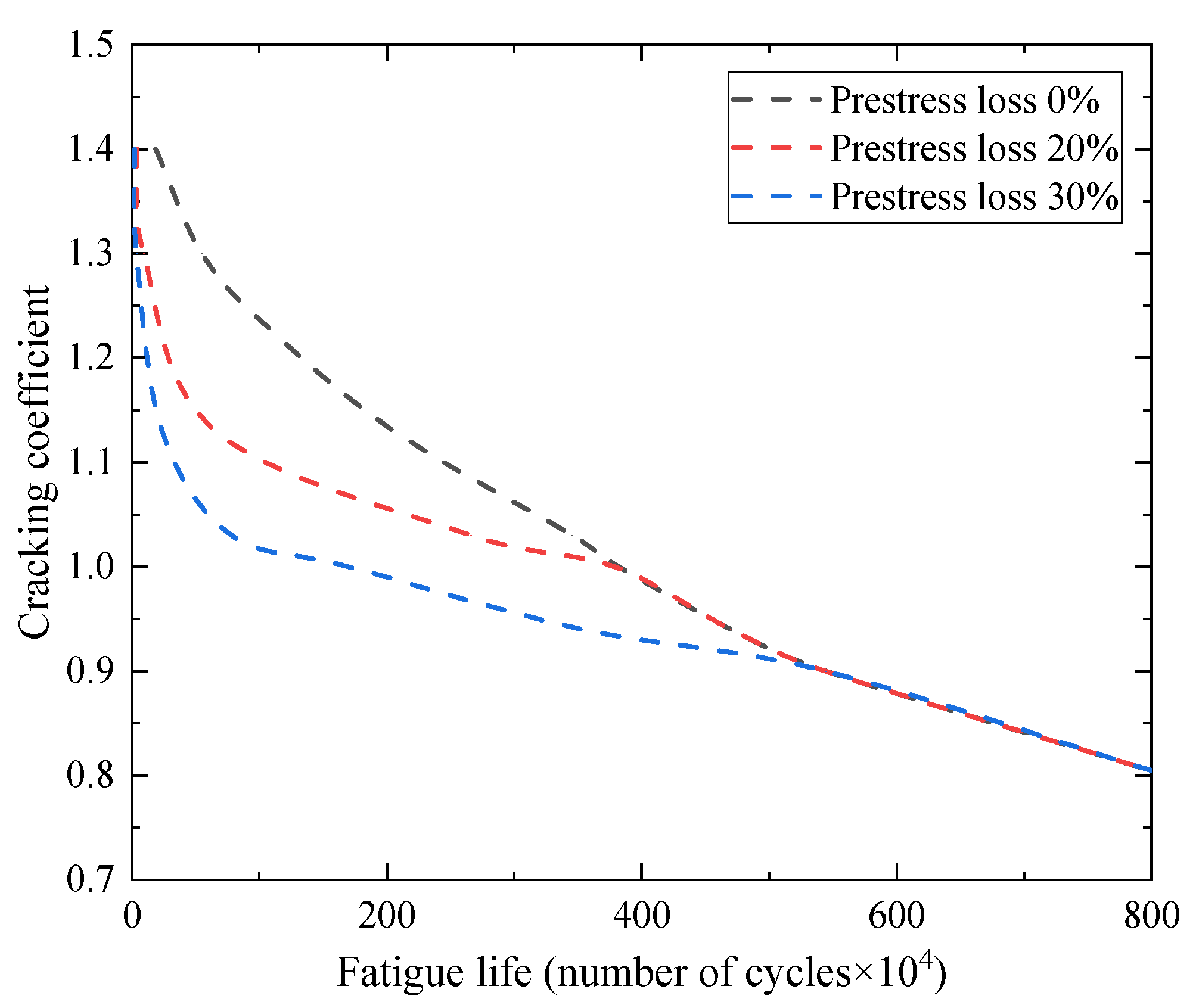

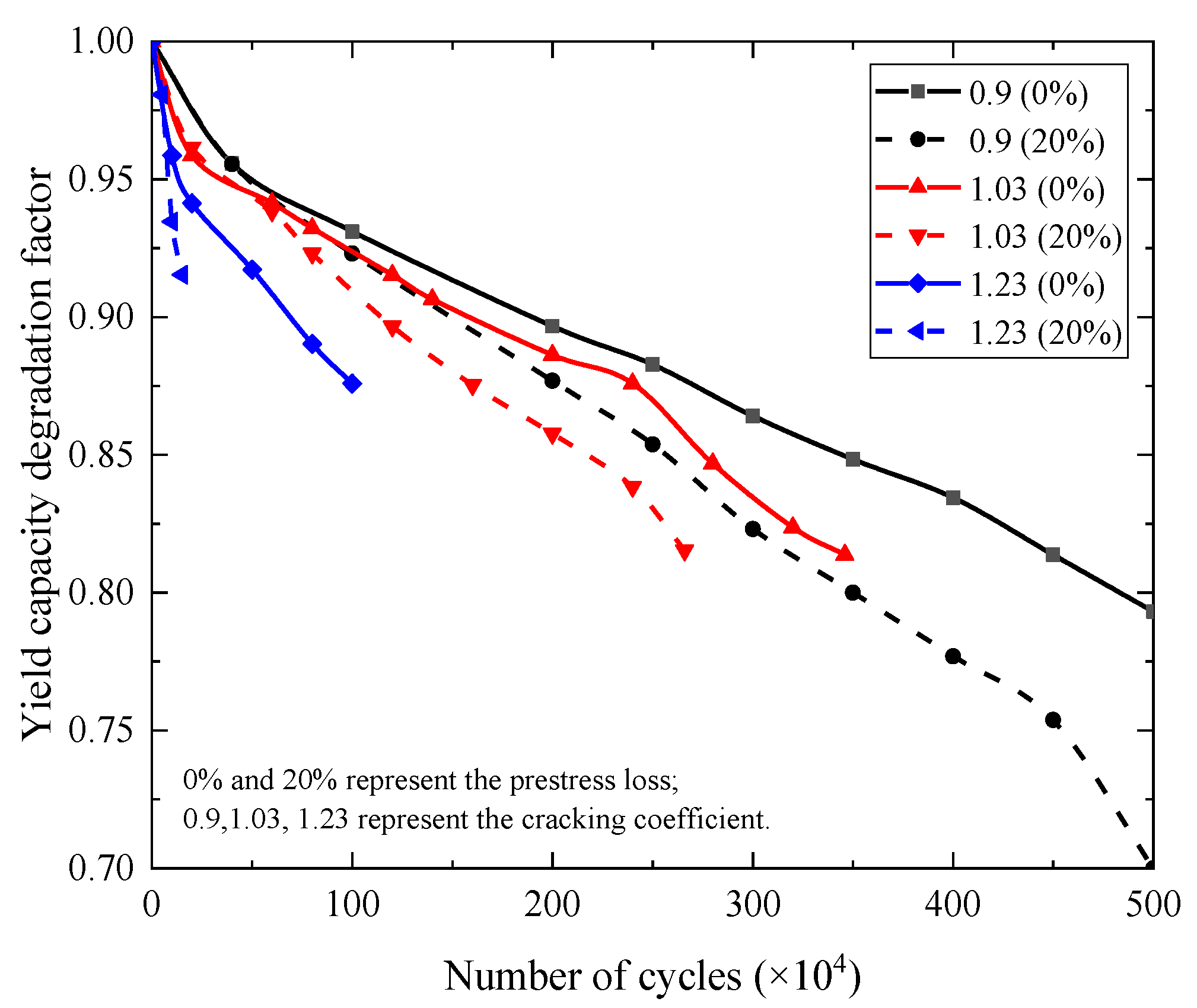
| Mixture | Cement | Water | Sand | Aggregate |
|---|---|---|---|---|
| Mixture ratio (kg/m3) Types | 495 P·II52.5R Portland cement | 176 Tap water | 648 Natural river sand | 1152 Crushed limestone |
| Types | Nominal Diameter d (mm) | Yield Strength fy (MPa) | Ultimate Strength fu (MPa) | |
|---|---|---|---|---|
| Longitudinal reinforcement | HRB335 | 10 | 405 | 475 |
| Stirrup | Q235 | 8 | 310 | 455 |
| Specimen Number | Applied Load at the Crack, Yield, and Ultimate, Pc, Pu (kN) | Load Range (kN) | Load Level | Cracking Coefficient | Fatigue Life (×104) | |
|---|---|---|---|---|---|---|
| Pmin | Pmax | Pmax/Pu | Pmax/Pc | |||
| S1 | 157.0, 324.2 | - | - | - | - | - |
| C1 | - | 11.42 | 136 | 0.42 | 0.85 | - |
| C2 | - | 11.42 | 149 | 0.46 | 0.93 | 600 |
| C3 | - | 11.42 | 165 | 0.51 | 1.03 | 301 |
| C4 | - | 11.42 | 196 | 0.60 | 1.23 | 91 |
| The First Batch of Prestress Loss σlI = σl1 + σl2 + σl4 | The Second Batch of Prestress Loss σlII = σl5 + σl6 | The Effective Prestress of Prestressing Strand | |||||
|---|---|---|---|---|---|---|---|
| σl1 | σl2 | σl4 | σlI | σl5 | σl6 | σlII | σpⅡ = σcon − σlI − σlII |
| 17.58 | 243.75 | 55.10 | 316.43 | 43.59 | 101.47 | 145.06 | 933.51 |
Publisher’s Note: MDPI stays neutral with regard to jurisdictional claims in published maps and institutional affiliations. |
© 2022 by the authors. Licensee MDPI, Basel, Switzerland. This article is an open access article distributed under the terms and conditions of the Creative Commons Attribution (CC BY) license (https://creativecommons.org/licenses/by/4.0/).
Share and Cite
Song, L.; Liu, R.; Cui, C.; Yu, Z.; Zhang, W. Fatigue Behavior of Heavy-Haul Railway Prestressed Concrete Beams Based on Vehicle-Bridge Coupling Vibration. Materials 2022, 15, 2923. https://doi.org/10.3390/ma15082923
Song L, Liu R, Cui C, Yu Z, Zhang W. Fatigue Behavior of Heavy-Haul Railway Prestressed Concrete Beams Based on Vehicle-Bridge Coupling Vibration. Materials. 2022; 15(8):2923. https://doi.org/10.3390/ma15082923
Chicago/Turabian StyleSong, Li, Ran Liu, Chenxing Cui, Zhiwu Yu, and Wenchang Zhang. 2022. "Fatigue Behavior of Heavy-Haul Railway Prestressed Concrete Beams Based on Vehicle-Bridge Coupling Vibration" Materials 15, no. 8: 2923. https://doi.org/10.3390/ma15082923






